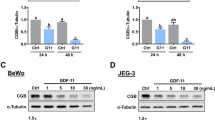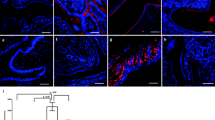Abstract
Purpose
We investigated whether the pregnancy-related hormones, estriol (E3), testosterone, human placental lactogen (hPL), human prolactin (hPRL), and human chorionic gonadotropin (hCG) affect BCRP expression in human placental BeWo cells.
Materials and Methods
The effects of these hormones on BCRP protein and mRNA expression in BeWo cells were determined by immunoblotting and quantitative real-time RT-PCR, respectively. The effects of these hormones on membrane localization of BCRP in BeWo cells were examined by immunofluorescent confocal microscopy.
Results
E3, hPL, and hPRL significantly increased BCRP protein and mRNA approximately two to threefold at physiological concentrations. Induction of BCRP by E3 was abrogated by the estrogen receptor (ER) antagonist ICI-182,780. However, knock-down of ERα by RNA interference did not abolish the inductive effect of E3. Testosterone by itself did not affect BCRP expression at physiological concentrations. However, testosterone together with 17β-estradiol (E2) increased BCRP protein and mRNA approximately twofold, and this induction was abolished by ICI-182,780 or the testosterone receptor (TR) antagonist flutamide or knock-down of ERα expression. Further analysis revealed that E2 increased TR mRNA approximately 5.9-fold, suggesting that testosterone in combination with E2 increases BCRP expression, possibly through E2-mediated up-regulation of TR. hCG at physiological concentrations had no effect on BCRP expression.
Conclusions
E3, hPL, hPRL, and testosterone in combination with E2 may up-regulate BCRP expression in the placenta during pregnancy.





Similar content being viewed by others
Abbreviations
- ABC:
-
ATP-binding cassette
- AhR:
-
aryl hydrocarbon receptor
- BCRP:
-
breast cancer resistance protein
- DMSO:
-
dimethyl sulfoxide
- E2 :
-
17β-estradiol
- E3 :
-
estriol
- hCG:
-
human chorionic gonadotropin
- HIF1α:
-
hypoxia-inducible factor 1α
- hPL:
-
human placental lactogen
- hPRL:
-
human prolactin
- JAK2:
-
Janus kinase 2
- P4 :
-
progesterone
- PBS:
-
phosphate-buffered saline
- STAT:
-
the signal transducers and activators of transcription
References
L. A. Doyle, W. Yang, L. V. Abruzzo, T. Krogmann, Y. Gao, A. K. Rishi, and D. D. Ross. A multidrug resistance transporter from human MCF-7 breast cancer cells. Proc. Natl. Acad. Sci. U. S. A. 95:15665–15670 (1998).
R. Allikmets, L. M. Schriml, A. Hutchinson, V. Romano-Spica, and M. Dean. A human placenta-specific ATP-binding cassette gene (ABCP) on chromosome 4q22 that is involved in multidrug resistance. Cancer Res. 58:5337–5339 (1998).
K. Miyake, L. Mickley, T. Litman, Z. Zhan, R. Robey, B. Cristensen, M. Brangi, L. Greenberger, M. Dean, T. Fojo, and S. E. Bates. Molecular cloning of cDNAs which are highly overexpressed in mitoxantrone-resistant cells: demonstration of homology to ABC transport genes. Cancer Res. 59:8–13 (1999).
Q. Mao, and J. D. Unadkat. Role of the breast cancer resistance protein (ABCG2) in drug transport. AAPS J. 7:E118–133 (2005).
L. A. Doyle, and D. D. Ross. Multidrug resistance mediated by the breast cancer resistance protein BCRP (ABCG2). Oncogene. 22:7340–7358 (2003).
Y. Zhang, A. Gupta, H. Wang, L. Zhou, R. R. Vethanayagam, J. D. Unadkat, and Q. Mao. BCRP transports dipyridamole and is inhibited by calcium channel blockers. Pharm. Res. 22:2023–2034 (2005).
M. Maliepaard, G. L. Scheffer, I. F. Faneyte, M. A. van Gastelen, A. C. Pijnenborg, A. H. Schinkel, M. J. van De Vijver, R. J. Scheper, and J. H. Schellens. Subcellular localization and distribution of the breast cancer resistance protein transporter in normal human tissues. Cancer Res. 61:3458–3464 (2001).
S. Cisternino, C. Mercier, F. Bourasset, F. Roux, and J. M. Scherrmann. Expression, up-regulation, and transport activity of the multidrug-resistance protein abcg2 at the mouse blood–brain barrier. Cancer Res. 64:3296–3301 (2004).
J. W. Jonker, J. W. Smit, R. F. Brinkhuis, M. Maliepaard, J. H. Beijnen, J. H. Schellens, and A. H. Schinkel. Role of breast cancer resistance protein in the bioavailability and fetal penetration of topotecan. J. Natl. Cancer Inst. 92:1651–1656 (2000).
C. M. Kruijtzer, J. H. Beijnen, H. Rosing, W. W. ten Bokkel Huinink, M. Schot, R. C. Jewell, E. M. Paul, and J. H. Schellens. Increased oral bioavailability of topotecan in combination with the breast cancer resistance protein and P-glycoprotein inhibitor GF120918. J. Clin. Oncol. 20:2943–2950 (2002).
P. Breedveld, N. Zelcer, D. Pluim, O. Sonmezer, M. M. Tibben, J. H. Beijnen, A. H. Schinkel, O. van Tellingen, P. Borst, and J. H. Schellens. Mechanism of the pharmacokinetic interaction between methotrexate and benzimidazoles: potential role for breast cancer resistance protein in clinical drug–drug interactions. Cancer Res. 64:5804–5811 (2004).
M. Hirano, K. Maeda, S. Matsushima, Y. Nozaki, H. Kusuhara, and Y. Sugiyama. Involvement of BCRP (ABCG2) in the biliary excretion of pitavastatin. Mol. Pharmacol. 68:800–807 (2005).
H. Zaher, A. A. Khan, J. Palandra, T. G. Brayman, L. Yu, and J. A. Ware. Breast cancer resistance protein (Bcrp/abcg2) is a major determinant of sulfasalazine absorption and elimination in the mouse. Mol. Pharm. 3:55–61 (2006).
F. Staud, Z. Vackova, K. Pospechova, P. Pavek, M. Ceckova, A. Libra, L. Cygalova, P. Nachtigal, and Z. Fendrich. Expression and transport activity of breast cancer resistance protein (Bcrp/Abcg2) in dually perfused rat placenta and HRP-1 cell line. J. Pharmacol. Exp. Ther. 319:53–62 (2006).
J. Kraemer, J. Klein, A. Lubetsky, and G. Koren. Perfusion studies of glyburide transfer across the human placenta: implications for fetal safety. Am. J. Obstet. Gynecol. 195:270–274 (2006).
C. Gedeon, J. Behravan, G. Koren, and M. Piquette-Miller. Transport of glyburide by placental ABC transporters: implications in fetal drug exposure. Placenta. 27:1096–1102 (2006).
H. Wang, X. Wu, K. Hudkins, A. Mikheev, H. Zhang, A. Gupta, J. D. Unadkat, and Q. Mao. Expression of the breast cancer resistance protein (Bcrp1/Abcg2) in tissues from pregnant mice: effects of pregnancy and correlations with nuclear receptors. Am. J. Physiol. Endocrinol. Metab. 291:E1295–1304 (2006).
H. E. Meyer zu Schwabedissen, M. Grube, A. Dreisbach, G. Jedlitschky, K. Meissner, K. Linnemann, C. Fusch, C. A. Ritter, U. Volker, and H. K. Kroemer. Epidermal growth factor-mediated activation of the map kinase cascade results in altered expression and function of ABCG2 (BCRP). Drug Metab. Dispos. 34:524–533 (2006).
H. Wang, L. Zhou, A. Gupta, R. R. Vethanayagam, Y. Zhang, J. D. Unadkat, and Q. Mao. Regulation of BCRP/ABCG2 expression by progesterone and 17beta-estradiol in human placental BeWo cells. Am. J. Physiol. Endocrinol. Metab. 290:E798–807 (2006).
M. Peter, H. G. Dorr, and W. G. Sippell. Changes in the concentrations of dehydroepiandrosterone sulfate and estriol in maternal plasma during pregnancy: a longitudinal study in healthy women throughout gestation and at term. Horm. Res. 42:278–281 (1994).
B. T. Zhu, G. Z. Han, J. Y. Shim, Y. Wen, and X. R. Jiang. Quantitative structure–activity relationship of various endogenous estrogen metabolites for human estrogen receptor alpha and beta subtypes: Insights into the structural determinants favoring a differential subtype binding. Endocrinology. 147:4132–4150 (2006).
M. A. Rivarola, M. G. Forest, and C. J. Migeon. Testosterone, androstenedione and dehydroepiandrosterone in plasma during pregnancy and at delivery: concentration and protein binding. J. Clin. Endocrinol. Metab. 28:34–40 (1968).
S. Batraand, and L. P. Bengtsson. 17 beta-Estradiol and progesterone concentrations in myometrium of pregnancy and their relationships to concentrations in peripheral plasma. J. Clin. Endocrinol. Metab. 46:622–626 (1978).
F. S. Khan-Dawood, and M. Y. Dawood. Estrogen and progesterone receptor and hormone levels in human myometrium and placenta in term pregnancy. Am. J. Obstet. Gynecol. 150:501–505 (1984).
J. Fujimoto, M. Nishigaki, M. Hori, S. Ichigo, T. Itoh, and T. Tamaya. The effect of estrogen and androgen on androgen receptors and mRNA levels in uterine leiomyoma, myometrium and endometrium of human subjects. J. Steroid. Biochem. Mol. Biol. 50:137–143 (1994).
O. O. Adesanya-Famuyiwa, J. Zhou, G. Wu, and C. Bondy. Localization and sex steroid regulation of androgen receptor gene expression in rhesus monkey uterus. Obstet. Gynecol. 93:265–270 (1999).
S. Rodriguez-Cuenca, M. Monjo, A. M. Proenza, and P. Roca. Depot differences in steroid receptor expression in adipose tissue: possible role of the local steroid milieu. Am. J. Physiol. Endocrinol. Metab. 288:E200–207 (2005).
M. J. Soares. The prolactin and growth hormone families: pregnancy-specific hormones/cytokines at the maternal–fetal interface. Reprod. Biol. Endocrinol. 2:51 (2004).
S. Handwerger. Clinical counterpoint: the physiology of placental lactogen in human pregnancy. Endocr. Rev. 12:329–336 (1991).
S. Handwerger, and M. Freemark. The roles of placental growth hormone and placental lactogen in the regulation of human fetal growth and development. J. Pediatr. Endocrinol. Metab. 13:343–356 (2000).
M. Freemark. Regulation of maternal metabolism by pituitary and placental hormones: roles in fetal development and metabolic programming. Horm. Res. 65(Suppl 3):41–49 (2006).
I. Sanchez-Vera, B. Bonet, M. Viana, A. Quintanar, and A. Lopez-Salva. Increased low-density lipoprotein susceptibility to oxidation in pregnancies and fetal growth restriction. Obstet. Gynecol. 106:345–351 (2005).
O. A. Kletzky, F. Rossman, S. I. Bertolli, L. D. Platt, and D. R. Mishell, Jr. Dynamics of human chorionic gonadotropin, prolactin, and growth hormone in serum and amniotic fluid throughout normal human pregnancy. Am. J. Obstet. Gynecol. 151:878–884 (1985).
V. Goffin, K. T. Shiverick, P. A. Kelly, and J. A. Martial. Sequence–function relationships within the expanding family of prolactin, growth hormone, placental lactogen, and related proteins in mammals. Endocr. Rev. 17:385–410 (1996).
H. Rui, J. Y. Djeu, G. A. Evans, P. A. Kelly, and W. L. Farrar. Prolactin receptor triggering. Evidence for rapid tyrosine kinase activation. J. Biol. Chem. 267:24076–24081 (1992).
C. Schindler, and J. E. Darnell, Jr. Transcriptional responses to polypeptide ligands: the JAK–STAT pathway. Annu. Rev. Biochem. 64:621–651 (1995).
J. Cao, P. M. Gowri, T. C. Ganguly, M. Wood, J. F. Hyde, F. Talamantes, and M. Vore. PRL, placental lactogen, and GH induce NA(+)/taurocholate-cotransporting polypeptide gene expression by activating signal transducer and activator of transcription-5 in liver cells. Endocrinology. 142:4212–4222 (2001).
J. W. Jonker, G. Merino, S. Musters, A. E. van Herwaarden, E. Bolscher, E. Wagenaar, E. Mesman, T. C. Dale, and A. H. Schinkel. The breast cancer resistance protein BCRP (ABCG2) concentrates drugs and carcinogenic xenotoxins into milk. Nat. Med. 11:127–129 (2005).
A. E. van Herwaarden, E. Wagenaar, G. Merino, J. W. Jonker, H. Rosing, J. H. Beijnen, and A. H. Schinkel. Multidrug transporter ABCG2/breast cancer resistance protein secretes riboflavin (vitamin B2) into milk. Mol. Cell. Biol. 27(4):1247–1253 (2007).
M. C. Neville, T. B. McFadden, and I. Forsyth. Hormonal regulation of mammary differentiation and milk secretion. J. Mammary Gland Biol. Neoplasia. 7:49–66 (2002).
S. Yasuda, S. Itagaki, T. Hirano, and K. Iseki. Expression level of ABCG2 in the placenta decreases from the mid stage to the end of gestation. Biosci. Biotechnol. Biochem. 69:1871–1876 (2005).
Y. Imai, E. Ishikawa, S. Asada, and Y. Sugimoto. Estrogen-mediated post transcriptional down-regulation of breast cancer resistance protein/ABCG2. Cancer Res. 65:596–604 (2005).
J. Cao, M. Wood, Y. Liu, T. Hoffman, J. Hyde, O. K. Park-Sarge, and M. Vore. Estradiol represses prolactin-induced expression of Na+/taurocholate cotransporting polypeptide in liver cells through estrogen receptor-alpha and signal transducers and activators of transcription 5a. Endocrinology. 145:1739–1749 (2004).
Acknowledgments
The authors acknowledge financial support from NIH grants HD044404 (to QM and JDU) and GM073715 (to QM). We also thank Yi Zhang, Lin Zhou, Eun-Woo Lee, and Weibin Zhou (Department of Pharmaceutics, University of Washington) for technical assistance in cell culture and immunoblotting.
Author information
Authors and Affiliations
Corresponding author
Rights and permissions
About this article
Cite this article
Wang, H., Unadkat, J.D. & Mao, Q. Hormonal Regulation of BCRP Expression in Human Placental BeWo Cells. Pharm Res 25, 444–452 (2008). https://doi.org/10.1007/s11095-007-9432-z
Received:
Accepted:
Published:
Issue Date:
DOI: https://doi.org/10.1007/s11095-007-9432-z




